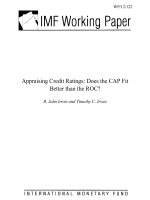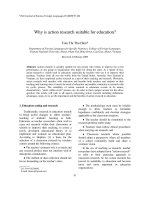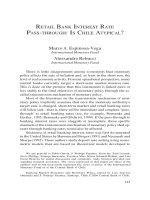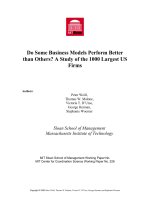Why is their recovery better than ours? (Even though neither is good enough) pptx
Bạn đang xem bản rút gọn của tài liệu. Xem và tải ngay bản đầy đủ của tài liệu tại đây (1.43 MB, 18 trang )
I am grateful to Tomas Hellebrandt and Marilyne Tolle for their research assistance and many helpful
suggestions in the preparation of this speech. I alone am responsible for the views expressed and
any errors herein, and these views should not be attributed to the Bank, the MPC, or to PIIE.
All speeches are available online at www.bankofengland.co.uk/publications/speeches
Why is their recovery better than ours? (Even though neither
is good enough)
Speech given by
Adam Posen, External Member of the Monetary Policy Committee, Bank of England and
Senior Fellow, Peterson Institute for International Economics
At the National Institute of Economic and Social Research, London
27 March 2012
All speeches are available online at www.bankofengland.co.uk/publications/speeches
2
2
“So here I am, my affections torn between a [UK] postal service that never feeds me but can tackle a
challenge and one [US] that gives me free tape and prompt service but won't help me out when I can't
remember a street name. The lesson to draw from this, of course, is that when you move from one country to
another you have to accept that there are some things that are better and some things that are worse, and
there is nothing you can do about it Now if you will excuse me I have to drive to Vermont and collect some
mail from a Mr. Bubba.” ― Bill Bryson, I'm a Stranger Here Myself: Notes on Returning to America After
20 Years Away
Why is Their Recovery Better than Ours?
(Even though neither is good enough)
Adam S. Posen
Comparing economic policy and performance across countries is a rewarding pursuit intellectually, and
sometimes in the form of policy relevant insights. Tonight, I would like to directly compare policy and
performance in the United Kingdom and the United States since the current less-than-satisfying recovery
began in both countries in mid-2009. Perhaps obviously, this comparison is of great personal concern to me,
given my residence and work here in London, while retaining ongoing ties personally and professionally in
Washington and throughout the US. But it is worth attention for more than just that, or even just for
Anglo-American bragging rights. While there are obviously some real differences between these economies,
there are many reasons that I will argue that this is a fair and revealing comparison. And just as Bill Bryson
found when comparing his experiences with the Royal Mail with those he had with the US Postal Service,
even if apparent efficiency seems to be greater in the US, there are some advantages to UK institutions that
also have to be taken into account when fully assessing performance. Flexibility – that defining aspect of
liberal market systems, which both of our economies can credibly claim to be – takes different forms on the
opposite sides of the Atlantic, leading to different results. And unlike in Bill Bryson’s quote, I believe that we
can do something about some of them.
My basic goal is to offer an explanation why the US economy has had a better recovery than the UK
economy from the global financial crisis so far. Our economies suffered largely the same type and size of
shock at roughly the same time, and our respective central banks have pursued roughly the same type and
size of counter-cyclical policy response – thankfully, in my view. Yet, the US has had significantly more GDP
growth with somewhat lower inflation over the last thirty-two months than in the UK. Why is that? It seems
to me that there are three sets of explanatory factors:
Corporate investment rebounded much more in the US than the UK because
o there were more non-bank options available to provide financing for investment
o there was less spillover from euro area risks on to the US than the UK banks
Household consumption rebounded much more in the US than the UK because
o there was significantly less net withdrawal of fiscal stimulus in the US than UK
All speeches are available online at www.bankofengland.co.uk/publications/speeches
3
3
o there was a greater rise in energy costs faced by the UK than US consumer
Inflation was higher in the UK than in the US because
o the UK fiscal tightening took in part the form of a Value-Added Tax increase
o Sterling depreciated more and more rapidly than the Dollar did
The vast majority of these factors are temporary or cyclical in nature, with the exception of the structural
failures of the UK financial system for domestic credit, whose importance I have long stressed
(Posen (2011a)). Many of the factors that some would suggest indicated a structural, and thus harder to
change, reason for the relative weakness of the UK recovery than in the US – such as differences in the
indebtedness of households or the desire to make risky investments or the housing markets – play no real
role in explaining the performance gap, to my mind. If anything, I fear that the structural issues in the US
labor market may turn out to make recent productivity growth rates there unsustainable over the
medium-term. Despite that fact, I am hopeful that we are on the cusp of a more robust recovery in both
economies - in the absence of premature policy tightening – and though the UK will take some time to catch
up with the US, it largely will.
I am grateful to be able to tackle this comparison here on the podium at NIESR tonight in the company of two
friends and close colleagues. Our host and chair, Jonathan Portes, is continuing the proud tradition of
NIESR Directors, as set by my MPC colleague Martin Weale, of keeping NIESR at the center of UK public
discussion about economic policy through publishing rigorous but sensible non-partisan analysis by the
NIESR staff. I am grateful to him for gathering this crowd for our joint discussion tonight. Our esteemed
guest, Eric Rosengren, President of the Federal Reserve Bank of Boston, has generously carved out time to
spend a few days with us at the Bank of England, as well as here at NIESR tonight, to promote learning from
each other. Eric was way ahead of the curve in his influential research on the importance of credit supply
and transmission of financial shocks, and went from that to showing true intellectual leadership on the FOMC
from the first signs of the global crisis through today. We can definitely learn a lot from him. I hope my own
remarks tonight will offer my two friends as well as all of you something to think about as well.
The recovery gap to explain –
The US recovery from the global financial crisis has been faster, stronger, and less inflationary than that in
the UK, at least so far. Both economies hit the trough in GDP in the second quarter of 2009, and have been
expanding since then. This is the period on which I want to focus. More than just the similarity in timing,
there is a strong similarity in other factors as well. The initial shock was quite similar in size and nature for
these two economies. Equity prices, house price inflation, bank lending, and residential construction all fell
at very similar sharp rates over the 2007-08 period, and obviously both countries faced the same global
All speeches are available online at www.bankofengland.co.uk/publications/speeches
4
4
contraction.
1
Both countries are in the grand scheme of things liberal market economies, with democratic
institutions, secure property rights, low average inflation for more than a decade pre-crisis, and so on. The
UK is of course much smaller and more open to the world economy than the US is, as well as much more
tied to Europe (less tied to Asia). Both economies, however, actually gained similar amounts of GDP from
net trade during the downturn of 2008-09, because imports fell rapidly with the contraction.
As can be seen in Figure 1, however, the US has bounced back in GDP terms much more strongly,
especially since 2010:Q3 (remember that date). This is because the UK economy has been largely stalled
since then, while the US continued on its recovery trend. At this point, the US GDP is back to its pre-crisis
level, up over 6% from the trough, and had we in the UK continued along our initial recovery path, we would
be on course to return to pre-crisis GDP level by third quarter of this year. Even the better US recovery is
rather weak compared to most prior post-war recoveries, considering how long it took to regain the past
output level, and our present UK recovery is historically quite paltry. No one should be satisfied with the
levels of unemployment and underemployed resources in either economy, even though there is ample
historical precedent for slower recoveries following financial crises than following other types of recessions.
But for tonight, the key question is why has the US recovery been so much stronger?
Figure 2 reveals the proximate causes of the differences. These bar charts decompose the total increase in
GDP since 2009:Q2 into the main income accounting components (Public and private investment, public and
private consumption, stock building/inventories, net foreign trade, and a small residual). The left pair of
stacked bars gives the percentage breakdown by component, and the right pair of bars gives the cumulative
contribution by component. Hence, on the right, the US stacked bar nets out to 6.2%, while the UK stacked
bar cumulates to 3.4%. Two components make this already sizable 2.8% growth gap to explain even bigger.
One, the UK had much greater increase in net trade in the recovery than the US. This befits a more open
economy whose currency depreciated more and more rapidly than its comparator. Two, government
consumption rose in the UK while contracting in the US during the recovery. This is because fiscal automatic
stabilizers are much bigger in the UK, and the UK was further from growing at trend in the recovery than the
US, both of which pushed up the amount of outlays (which State and Local budget constraints in the US
caused cuts offsetting Federal level transfers). These factors combined add another 2% or more to the gap
in growth between the UK and the US economies that has to be explained.
So where did the US growth come from? It is clear from figure 2 that both private consumption and
investment grew much more strongly in the US than in the UK – so much more strongly that they more than
offset the UK’s boost from net trade and bigger stabilizers. Consumption grew by a whopping
3.8 percentage points in the US since mid-2009, while only growing by 0.7 percent cumulatively in the UK;
investment grew by 1.7% in the US and only 0.6% in the UK over the course of this recovery (Also a factor
1
In the interest of time and space, I am not presenting here figures showing these parallel paths, but they are available. Technical note:
the similarity of UK-US house price inflation moves holds if one uses the Case-Shiller index of house prices for the US; using the FHFA
measure there is a greater divergence.
All speeches are available online at www.bankofengland.co.uk/publications/speeches
5
5
was three times the growth from stockbuilding in the US than the UK, but that should be seen as the result of
the greater growth from these domestic demand sources, amplifying them, but not even a proximate cause in
and of itself). These are in the Bank of England parlance rather chunky numbers, and are what we have to
explain.
Reasons for the difference in investment growth –
One way to explain the difference in the recovery of private investment in the US from the UK would be to
say that businesses were (correctly) more optimistic about growth prospects in the US than the UK, and
invested accordingly. I find this kind of argument rather circular in nature, except to the degree that there
was a foreknown driver of consumption growth in the US that was not really present in the UK. I address this
possible explanation in the next section of my remarks. But taking this claim on its own terms, it seems
suspect in the current recovery as an explanation for the US’ relative investment boom:
Equity prices, which should offer some indication of the prospects for future growth in corporate
profits, have risen by very similar amounts in the UK and US
2
;
Net exports, and manufacturing in particular, in the UK and US have both “come back” roughly to the
degree that the countries’ respective currency adjustments would have predicted, and thus more so
in the UK than in the US, consistent with adaptability;
Corporate bankruptcy rates rose by similar amounts (50%) versus their pre-crisis averages in both
countries, and were more volatile in the US than in the UK;
Corporations in both the UK and US are sitting on historically unprecedented hoards of cash rather
than investing that cash (or returning it to shareholders), although a little more so in the UK than in
the US; and,
The share of private gross fixed capital formation in GDP has been stable in both countries at the
same level (around 12% of GDP), so investment rose in the US only proportionately with the growth
as it came through, rather than shifting upwards in prospect.
So what explains the difference in investment - besides stronger growth in something else, aka consumption,
which may be it?
Monetary policy certainly is not a source of difference, at least in intent. The Bank of England’s MPC and the
Federal Reserve’s FOMC responded to the global crisis with largely the same aggressive – and to my mind
wholly justified – scale and pace of monetary easing. Both central bank policy boards cut their instrument
interest rates rapidly to zero, and when that was not enough, given the scale of the shock, they engaged in
quantitative easing. Figure 3 shows what is probably a by now familiar picture for those who bother coming
2
This holds true when looking at the broader stock indices which have a much higher component of companies with domestic markets
in them. The American and British equity indices in fact followed almost precisely the same time path – disturbing for diversification, but
indicating no difference in optimism.
All speeches are available online at www.bankofengland.co.uk/publications/speeches
6
6
to talks about macroeconomics by central bankers on a warm Tuesday evening: the FOMC and the MPC
tripled the size of their central banks’ respective balance sheets as a share of GDP, to 19% on current
programs. The balance sheet expansion took place mostly from mid-2008 through early 2009, and then the
Fed and the Bank of England undertook smaller additional expansions in late 2011 to present. One can
make something out of the differences in composition of what the two central banks purchased, or how the
purchases were communicated in the context of the monetary policy regime, and on another occasion I will
add my take on those issues. But to a first approximation, these are the same policy stance, offering roughly
the same amount of stimulus to the economy.
The similarity of stance makes sense given the similarity of shocks in scale and the comparable estimates on
both sides of the Atlantic of the impact on markets and the broader economy of a given amount of QE.
3
That
is, our best guess is that the transmission of monetary policy stimulus is largely the same in the UK and the
US during this recovery. One way to see this is through Figure 4, which shows that the growth in
non-financial credit has been largely similar in the US and UK during the recession and recovery. Their
paths have begun to diverge in the latter stages of the recovery, with the US recovering faster again from
mid-2010 onwards. This could reflect constraints on the growth in lending in the UK to SMEs and new
businesses which I had expressed concerns would kick in during the recovery; it also could reflect the
altogether stronger growth in the US than UK over this period. Either way, the marked trans-Atlantic
divergence in credit growth trends over the last two years is worrying, but is not yet sufficient in levels to
explain much of a difference in investment looking backwards.
The broadly parallel pattern of credit growth, however, does rule out the possibility that UK banks are
responding very differently in quantity terms to the same QE from the way that US banks responded. The
cumulative amount of bond and equity issuance by British and American non-financial corporate is roughly
the same as a percentage of GDP since mid-2009 as well – a little bit higher total bond market issuance by
US corporates (8% versus a little over 6%), a little lower total equity issuance (1.7% versus 2.5%).
4
Thus, to
the extent that QE makes it relatively more attractive for companies to pursue non-bank financing, it is having
a similar effect on both sides of the Atlantic as well.
5
What is happening then is that the US is getting more private investment than the UK (as a percent of GDP)
for the same amount of growth in bank credit and other forms of securities (as a share of GDP). One could
perhaps explain this by an accumulation of various small factors, some of which I have already mentioned.
This usually is an accurate way of understanding the situation, even if less than elegant. But I think two
broader factors are at work inhibiting the UK investment per pound financed in the current recovery versus
3
Bridges and Thomas (2012), Gagnon, et al (2010), Joyce, et al (2011), and Kapetanios, et al (2012) are studies that find reasonably
consistent, if understandably imprecise, estimates of the immediate impact of QE announcements on interest rates and eventually on
the broader economy. More recent studies in progress by Bank and Fed staff and independent academics that I have seen also seem
to reach similar estimates, though of course this is always subject to empirical challenge by fresh research.
4
I am grateful to the Bank staff, working with Tomas Hellebrandt, for gathering this data for me.
5
Of course, much more careful econometric work needs to be done than comparing aggregates, although under the circumstances this
is a pretty fair first cut. Again, see the references in footnote 4.
All speeches are available online at www.bankofengland.co.uk/publications/speeches
7
7
the US investment per dollar financed. One, I believe that there is greater misallocation of credit going on in
the UK economy at present than in the US, even if aggregate lending quantities are comparable.
(Posen (2011a, 2012)) This is due to the lack of competition in the UK banking system compared to the US,
and the smaller proportion of non-financial businesses which have access to loans, bonds, and/or
securitization thereof in the UK than in the US. Two, I believe that the ongoing financial and macroeconomic
risks to the euro area raise both the cost of credit and the need to provision for UK banks far above that for
most US banks, which further inhibits reasonable allocation of risk capital. This is due to the inherent
exposure of the UK economy to the euro area economies as well as the accumulated foreign lending to the
euro area by UK banks during the boom years. (Broadbent (2012))
If credit misallocation due to these factors is what leads to a lower rate of growth in private investment in the
UK than the US, then the difference in investment is not due to a difference in QE or its impact. Combine
this with greater actual domestic demand growth, not greater optimism, and quite a divergence in investment
emerges, as shown in Figure 5. UK investment has barely moved cumulatively throughout the recovery,
while US investment has risen by 12 percent from the trough. Had the MPC not followed a similarly
aggressive path of monetary stimulus to that of the FOMC, right up through the additional measures
undertaken since October 2011, it is frightening to imagine what would have happened British private
investment.
Reasons for the difference in consumption growth –
As I previously noted, the difference between American and British private consumption paths during this
recovery period has been if anything as marked as those in investment. US consumption only fell by half as
much as UK consumption did, peak to trough, and has since more than recovered to its pre-crisis level (see
Figure 6). Meanwhile, UK consumption did grow from 2009:Q2 through 2010:Q2, but has declined in five of
the last six quarters (of data) since that time. This is an even more unusual pattern than flat investment
growth, for the UK or almost any market economy, to have no recovery in consumption growth from the time
that the economy troughed in GDP terms.
Economists have a reasonably good understanding of short-term movements in household savings rate as a
share of income. As shown in the recent work of Carroll, et al (2012), a ‘buffer-stock’ model of savings
behaviour, where households respond to changes in their wealth-to-income ratio, in their uncertainty about
future income (usually proxied by unemployment measures), and in their access to credit (to smooth income
fluctuations), fits US data quite well. We have found that a quite similar but not identical approach in the UK
also fits the household consumption data quite well.
6
Thus, it is worth trying to understand the slow growth in
consumption through this lens.
6
The Bank staff and I have benefitted from input by Chris Carroll and by John Muellbauer. See Aron, et al (2010) for an example of the
latter and co-authors’ similar approach to UK and US data. This is not to say that either of these publications is the basis for any part of
the Bank’s ‘official’ model, let alone the MPC forecast.
All speeches are available online at www.bankofengland.co.uk/publications/speeches
8
8
There have been rather similar movements in household wealth in the UK and the US over this period (to be
shown below). Availability of credit to consumers, whether in the form of mortgages or unsecured loans
and credit cards, contracted greatly in both economies as well. It is uncertainty which accounts for a big part
of the difference. Unemployment rose by a greater amount in the US than in the UK, and peaked at 9.9% in
December 2009, before coming down to its current level of 8.3%; in the UK, unemployment rose to 7.9% in
June 2009, fluctuated between 7.7% and 8.0% until March 2011, and has since risen slowly to 8.3%.
Declining income uncertainty in the US, as proxied by unemployment, clearly played a role in the surge of
consumption growth from mid-2010 forward while uncertainty remained high in the UK.
Another large factor was stagnant or contacting real incomes in the UK versus in the US in recent years. As
household income declines, even a rising savings rate can get swamped in terms of net effect on
consumption. What has hit real disposable income in the UK over the last two years to cut off the recovery of
consumption? Two big factors: first, a tightening of fiscal policy, greater than that in the US; second, a
sharper rise in British energy prices than experienced by American consumers.
Figure 7 presents the general government fiscal balances of the UK and the US as compiled by the OECD
from national data. A bigger negative number indicates a larger deficit. Crucially, this general measure
includes the contributions of state and local governments (much bigger in the US than in the UK). This
general measure is also unadjusted for the business cycle, so it includes the effect of the differences in
automatic stabilizers between the US and UK.
7
For almost the entire period since March 2007, and
particularly since March 2010, the US has run a looser overall fiscal stance – a more stimulative fiscal policy
– than the UK, even taking the full operation of the larger automatic stabilizers in the UK into account.
Cumulatively, since 2007Q1, the difference has amounted to 3% of GDP.
8
As with monetary policy, one has to think about the transmission of fiscal policy to understand the size and
nature of the impact. What would the respective multipliers be on the UK’s and the US’s fiscal policy
measures? The usual assumption is that the larger, less open economy would have bigger multipliers, since
there would be less leakage from its fiscal policies. Yet, the impact of different fiscal policy measures varies
also by their design and incidence.
9
As has been widely argued, much of the recent US Federal
Government stimulus had relatively low multipliers, while the cutbacks at the state and local government
level had high multipliers. Similarly, I would argue, that the raising of the Value Added Tax in the UK was a
relatively high multiplier form of policy, as were the cutbacks by local authorities (though much smaller in
7
If one were assessing the amount of discretionary fiscal stimulus or tightening, one would want to look at cyclically adjusted central
government primary balances. That captures what the central government is choosing to do (while state and local governments are
constrained, particularly in the US, by budget rules). On that measure, the central UK government is closing its deficits at a faster rate
than the US federal government by a larger margin than shown here. While extremely important for the projection of fiscal sustainability
and the normative assessment of fiscal discipline, those measures would overstate the relative size and impact of the UK’s fiscal
contraction relative to the US in explaining the recovery to date.
8
In 2007-2008, the differences in fiscal stance between the British and American governments were small. They widened from 2009H1
forward, and did so at an increasing rate over 2010-11. On current stated policies by the respective incumbent governments, the
difference will continue to widen further through 2012.
9
Romer (2011) gives a masterful and policy relevant overview of the empirical evidence on countercyclical fiscal policy.
All speeches are available online at www.bankofengland.co.uk/publications/speeches
9
9
scale than in the US).
10
Furthermore, because all of the UK’s main trading partners besides the US, making
up over 70% of UK export markets, were simultaneously undertaking fiscal austerity programs to varying
degrees, the amount policy leakage was less in this case – if anything, UK austerity was being reinforced.
So it seems reasonable to believe that the multiplier on UK fiscal measures since mid-2010 was on the order
of 1.0 or higher. That would then constitute a sizable share of the growth differential between the US and
the UK over this recovery period.
11
Figure 8 shows the other significant drag on UK household incomes during this period, the rise in oil prices.
Given the depreciation of Sterling over 2008, the increase in UK domestic prices in oil costs was 25% higher
than in the US over 2009-12. Additionally, the amount which home energy suppliers raised their tariffs in
2010-11 in the UK was much higher than in the US, further cutting into real incomes (this was partially offset
by some reductions in home energy prices in fall 2011). And of course, while a currency depreciation aids in
adjustment and increases net exports under normal circumstances, and has done so for the UK since 2008,
it also cuts real purchasing power of foreign goods. All told the UK consumer suffered a set of severe
one-time shocks to real income in 2009-2012, most of which we can hope are now coming to an end.
Some have asserted that it is UK household indebtedness which has kept consumption growth down here
relative to the US, where there was less debt and more deleveraging. As my MPC colleague Ben Broadbent
(2012) has rather convincingly argued, this contention does not seem to hold water. One way to see this is
to look at Figure 9, which shows the level and the change in household gearing, that is households’ total
liabilities divided by total assets. This is arguably more relevant for consumption behaviour than comparing
debt to income ratios. As can be seen in the left panel of the figure, UK and US household gearing have
been essentially equivalent since gearing peaked at the start of the crisis, and in fact UK gearing has
declined a touch more rapidly. As seen in the right panel, the broad swings in gearing have been little
different across the two economies, at least on average, in timing or even in amplitude (except at the height
of the boom and bust).
In the UK, this has been driven by the relative matching of household assets and liabilities, because most
debt has gone into housing, and housing in the UK has seen smaller price falls than in the US, while
mortgage rates have adjusted downwards in the UK. This pattern arguably reflects the lack of expansion in
British housing supply during the boom years. I do not wish to sound overly sanguine on this point – UK
housing prices have fluctuated more than US housing prices over the long run, in part because supply is less
elastic, and a major decline in housing prices when adjustable rate mortgages are already at low rates could
10
See Posen (2012b). As I stated before the TSC then, and on several prior occasions, I do not offer a normative evaluation of the
merits of the current or prior government’s fiscal policies. It is elected officials, and not technocrats like central bankers, who should
make the political decisions about tradeoffs between long- and short-term concerns, as well as about the risks to credibility. But I do
need to be as objective as possible about the past impact of fiscal policies in order to make my forecasts and to set monetary policy. It
is in that pursuit that I offer these assessments.
11
There is a long record of officials and economic commentators underestimating the short-run multiplier on consumption tax increases.
A notable example was Japan in 1997.
All speeches are available online at www.bankofengland.co.uk/publications/speeches
10
10
do real damage to household balance sheets. But looking backward to explain the difference in
consumption patterns, there is little to appeal to UK household debt as a factor.
Inflation differences are temporary –
It is necessary to explain why inflation was higher in the UK than in the US when recovery was stronger in
the US than in the UK over this period. The answer, however, is very simple, and has been offered by my
MPC colleagues and myself on several occasions, so I will be brief: temporary factors from one-time shocks
pushed up the inflation rate. There was no drift in overall inflation trend and minimal wage- or domestically
generated inflation. Figure 10 shows comparable core inflation measures for the UK and the US. The
vertical move in January 2010 is the VAT increase, and the subsequent one is visible in December
2010/January 2011. These factors are now dropping out of the UK inflation rate.
If UK core inflation does not continue to fall relatively steadily and quickly back towards target, then there has
been some sort of shift in the inflation process, and that would be cause for worry. (Posen (2012b)) There
is, however, no convincing evidence to date that such a shift has occurred. Wage growth continues to be
quiescent in line with what a Phillips curve approach would forecast, and financial market expectations for
longer-term inflation have remained well anchored in the UK. (Posen (2012a))
There has been some relative rise in inflation expectations for the UK versus the US. Figure 11 shows UK
minus US instantaneous inflation forward rates from traded options at the five- and ten-year horizons, and
they have of late settled at 0.5 and 1.0 percent higher respectively for the UK versus the US.
12
But this
differential is smaller than it was prior to the crisis, and in fact the differential has been coming down on
average during the period that inflation overshot the MPC’s target and we were pursuing QE. Why the
differential began to rise in mid-2006 is a question for future research, but clearly UK inflation has become
more anchored in financial market expectations by this measure over the course of the recovery, not less.
This pattern is borne out by some recent research completed by Kenneth Kuttner and myself (2012). We
examined whether the flexibility with respect to responding to short-term inflation movements (justifiably)
exhibited by the MPC over the crisis period cost us versus the FOMC, where no explicit inflation target was
in place. We found that inflation targeting can be quite flexible without losing counter-inflationary credibility.
Figure 12 shows how quickly the Consensus Forecasts of inflation thought that inflation would come back to
target level in the UK (on the right) and the US (on the left). The likelihood and speed of returning to target
derived from analyzing these professional forecasts was just as high in the UK as in the US over even the
crisis period (through 2010). This is another way of showing that inflation expectations remain
well-anchored.
12
The difference is not because markets decided to start expecting deflation in the US.
All speeches are available online at www.bankofengland.co.uk/publications/speeches
11
11
Why was it better over there? Will it remain so? –
Why was the US recovery since the global crisis stronger than in the UK, particularly since mid-2010? The
shocks were almost the same for both countries, and net trade and automatic stabilizers only add to the gap
to be explained. The key differences were in investment and consumption behaviour. Investment
responded similarly in quantity terms of lending and issuance, as well as in interest rate effects, to the
similarly scaled quantitative easing undertaken on both sides of the Atlantic. Monetary policy and its
effectiveness were not the source of difference, nor was business optimism (especially since forecasts for
UK growth, not just the MPC’s, surprised on the downside). Credit was more poorly allocated in the UK,
producing less investment for a given pound of credit or financing issued. The spillovers of risk from the euro
area on the UK financial system, inherently much less of a problem for the US financial system, also
distorted the cost of capital and risk taking behaviour.
Equally critical to investment and to stockbuilding as sources of the US relative growth advantage, however,
was the underlying growth that drove them. Consumption grew more strongly in the US than in the UK, with
consumption growth stagnating in the UK from Spring 2010 onwards. Deleveraging by households was not
a major factor, given the comparable state of US and UK balance sheets. The contrasting directions of
employment trends raised uncertainty in the UK over the US during the latter half of the recovery, which
weighed on consumption. Fiscal policy, however, played an important role as well. Cumulatively, the UK
government tightened fiscal policy by 3% more than the US government did – taking local governments and
automatic stabilizers into account – and this had a material impact on consumption. This was particularly
the case because a large chunk of the fiscal consolidation in 2010 and in 2011 took the form of a VAT
increase, which has a high multiplier for households. The fact that British real incomes were hit harder than
American households’ incomes by energy price increases could be ascribed in large part to the past
depreciation of Sterling, which also hit real incomes directly. All combined, these factors significantly
dampened consumption growth in the UK, with knock on effects on investment and stockbuilding.
Going forward, most of these factors causing the difference between UK and US behaviour will recede.
Inflation is only a temporary difference, and the national rates are now converging on their long-run targets.
On official forecasts, fiscal policy is likely to remain more contractionary in the UK than the US for a couple of
years to come, but the difference will shrink significantly from both ends over the next couple of years.
Monetary policy is continuing to support recovery of investment in both economies, and must continue to do
so. A longer-term troubling difference is in the apparent relative inefficiency of the British domestic finance
system in allocating capital to businesses. While some of that should recede when the banks build up their
capital buffers, and if and when euro area risks themselves recede, there remains a clear structural agenda
for the UK to deal with in its financial system. (Posen (2011a, 2012a))
All speeches are available online at www.bankofengland.co.uk/publications/speeches
12
12
Figure 1: GDP recovery since mid-2009
Source: Quarterly national accounts, OECD.
Note: trough in GDP is in 2009 Q2.
Figure 2: Decomposition of GDP growth in the recovery
Source: Quarterly National Accounts, OECD
Note: Recovery is defined as the period from the trough in GDP (2009 Q2) to the latest data (2011 Q4)
All speeches are available online at www.bankofengland.co.uk/publications/speeches
13
13
Figure 3: Central bank balance sheets
Source: Bank of England and Federal Reserve.
Figure 4: Bank lending to non-financial private sector
Source: Flow of funds and authors’ calculations for the US, Bank of England for the UK.
Note: excludes the effects of securitisations and loan transfers.
0
2
4
6
8
10
12
14
16
18
20
Mar-07 Sep-07 Mar-08 Sep-08 Mar-09 Sep-09 Mar-10 Sep-10 Mar-11 Sep-11
Federal Reserve
Bank of England
% of GDP
All speeches are available online at www.bankofengland.co.uk/publications/speeches
14
14
Figure 5: Private investment recovery
Source: Quarterly national accounts, OECD.
Note: trough in GDP is in 2009 Q2.
Figure 6: Private consumption
Source: Quarterly national accounts, OECD
Note: Pre-recession peak in GDP is 2008 Q1 for the UK and 2007 Q4.
All speeches are available online at www.bankofengland.co.uk/publications/speeches
15
15
Figure 7: General government fiscal balance
Source: OECD. General government includes Federal, State and Local government
Figure 8: Oil price (home currency)
Source: Bloomberg
All speeches are available online at www.bankofengland.co.uk/publications/speeches
16
16
Figure 9: Household capital gearing
Note: Capital gearing is defined as total liabilities divided by total assets.
Source: ONS and Bank of England for the UK and Federal Reserve and Flow of Funds for the US.
Figure 10: Core inflation
Source: Eurostat (UK) and US Bureau of Labor Statistics (US).
Note: Excludes food and energy (US and UK) and alcohol and tobacco (UK).
All speeches are available online at www.bankofengland.co.uk/publications/speeches
17
17
Figure 11: Long-term market inflation expectations
Source: Bloomberg and Bank of England calculations.
Figure 12: Median inflation forecasts
UK median inflation forecasts US median inflation forecasts
Source: see Figures 9 and 10, p.85 in “How Flexible Can Inflation Targeting Be
?” by Ken Kuttner and Adam Posen, International
Journal of Central Banking, Vol. 8 No. S1, January 2012.
All speeches are available online at www.bankofengland.co.uk/publications/speeches
18
18
References
Aron, J, Duca, J, Muellbauer, J, Murata K and A Murphy (2010), “Credit, Housing Collateral and
Consumption: Evidence from the UK, Japan and the US”, University of Oxford Discussion Paper Series
Number 487, May 2010.
Bridges, J and Thomas, R (2012), “The impact of QE on the UK economy — some supportive monetarist
arithmetic”, Bank of England Working Paper No.442, January 2012.
Broadbent, B (2012), “Deleveraging
”, speech given at Market News International, London, 15 March 2012.
Carroll, C, Slacalek, J, and M Sommer (2012), “Dissecting Saving Dynamics: Measuring Wealth,
Precautionary, and Credit Effects”, in progress.
Daly, M, Hobijn, B, Sahin, A and R, Valletta (2011), “A Rising Natural Rate of Unemployment: Transitory or
Permanent?”, Federal Reserve Bank of San Francisco Working Paper 2011-05
Gagnon, J, Raskin, M, Remache, J, and B Sack (2010), “Large-scale Asset Purchases by the Federal
Reserve: Did They Work?”, Federal Reserve Bank of New York Staff Report No.441.
Joyce, M, Tong, M and R Woods (2011), “The United Kingdom's quantitative easing policy: design,
operation and impact”, Quarterly Bulletin 2011 Q3: 200-212.
Kapetanios, G, Mumtaz, H, Stevens, I and K, Theodoridis (2012), “Assessing the economy-wide effects of
quantitative easing”, Bank of England Working Paper No.443, January 2012.
Kuttner, K and A, Posen (2012), “How Flexible Can Inflation Targeting Be and Still Work?
”, International
Journal of Central Banking, Vol.8 No.S1: 65-99, January 2012.
Posen, A (2011a), “How To Do More
,” speech given at Wotton-under-Edge, Gloucertershire,
13 September 2011.
Posen, A (2011b), “The Soft Tyranny of Inflation Expectations,” International Finance, 14(3): 541-566,
Winter
Posen, A (2012a), “Deepen and Diversify UK Financial Infrastructure to Enable Small Business Growth
”,
remarks presented at the TUC Panel “Banking after Vickers”, 2 February 2012.
Posen, A (2012b). Annual Report to the Treasury Select Committee, House of Commons,
29 February 2012. Available on:
Romer, C (2011), “What do we know about the effects of fiscal policy? Separating evidence from ideology,”
speech at Hamilton College, 07 November 2011. Available on:
/>









